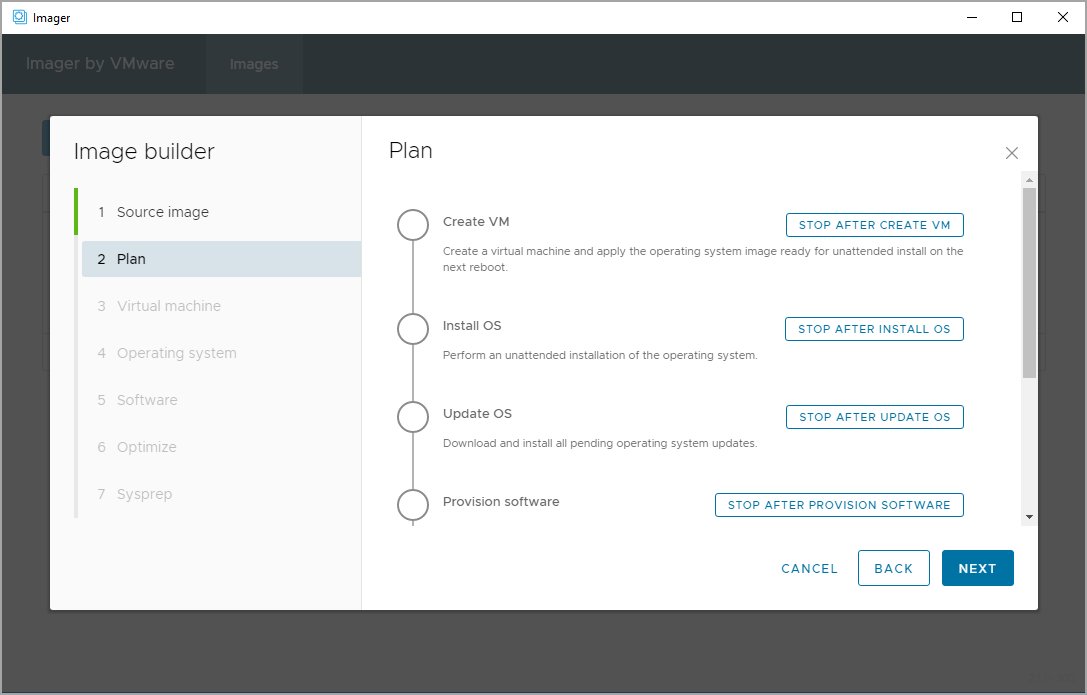In this blog post, we’ll be discussing VMware Imager 2.1 Fling software (recently updated) and how it compares to Microsoft Deployment Toolkit (MDT). We’ll go over the key features of both tools, the advantages and disadvantages of each, and how to decide which one is the best fit for your organization’s needs.
First, let’s define both tools:
- VMware Imager is a free tool from VMware that allows you to automate the creation and deployment of virtual machine images from Windows ISOs. It is typically used in conjunction with vSphere, so you can prepare desktop or server images ahead of time, to be deployed later into vSphere or Horizon environments. An option to pre-install a software packages within the deployment process is also available.
- Microsoft Deployment Toolkit (MDT) is a free tool from Microsoft that allows you to automate the deployment of Windows operating systems and applications. It is typically used in conjunction with the System Center Configuration Manager (SCCM) to manage and deploy Windows machines in an enterprise environment, but you must also satisfy other system requirements such as installation and configuration of Windows ADK and the WinPE add-in for Windows ADK. VMware imager on the other hand does not require any other software to be installed (it’s done automatically under the cover) and you can use any Windows based workstation, as a host.
Now that we have a basic understanding of each tool, let’s delve into the key features of each.
VMware Imager 2.1:
- Allows you to create and deploy virtual machine images
- Supports Windows operating system
- Integrates with vSphere, Horizon or VMware One.
- Offers advanced features such as image customization and image deployment automation
Microsoft Deployment Toolkit:
- Allows you to automate the deployment of Windows operating systems and applications
- Integrates with SCCM, Microsoft’s systems management platform
- Offers advanced features such as image customization and deployment automation
- Supports deployment to physical and virtual machines
Now that we’ve covered the key features of each tool, let’s discuss the advantages and disadvantages of each.
Advantages of VMware Imager 2.1:
- Free to use
- Integrates with vSphere, a popular and powerful virtualization platform
- Offers advanced features such as image customization and deployment automation
- NEW: Paravirtualized Drivers – VMs can now be built with the paravirtualized drivers for storage (PVSCSI) and network (VMXNET3). Use of these drivers offers greater performance, throughput, and CPU utilization.
- OVF Export – VMs can be exported from any stage in the build plan to OVF or OVA formats.
Virtual Machine specifications
Disadvantages of VMware Imager:
- Limited to virtual machine deployments but much simpler to setup and use
- May not be as well-known or widely used as MDT
- Installation of VMware Player (Free) or Workstation (paid)
Advantages of Microsoft Deployment Toolkit:
- Free to use
- Integrates with SCCM (paid tool), a popular and powerful systems management platform
- Supports deployment to physical and virtual machines
- Offers advanced features such as image customization and deployment automation
Disadvantages of Microsoft Deployment Toolkit:
- Limited to Windows operating system deployments
- May require a learning curve for those unfamiliar with SCCM
So, which tool is the best fit for your organization’s needs? Here are some factors to consider when deciding:
- Virtual or physical deployments: If you need to deploy to physical machines, MDT is a clear choice. If you only need to deploy to virtual machines, either tool could work, depending on your other requirements.
- Integration with other tools: If you already use vSphere or SCCM in your organization, the corresponding tool (VMware Imager or MDT) may be a natural choice. If you don’t use either of these tools, you’ll need to weigh the pros and cons of each tool separately.
- Budget: Both tools are free to use, so cost should not be a factor in your decision.
In summary, VMware Imager and Microsoft Deployment Toolkit are both powerful tools for automating the deployment of operating systems and applications. VMware Imager is best suited for virtual machine deployments but it seems that VMware Imager is easier to install and configure.
Few screenshots from the latest VMware Imager 2.1 software. Here you can see how the tool works. Basically, all it does at the beginning is asks about the location of your ISO so it can start preparing the Operating system.
VMware Imager 2.1 Workflow
A lot of things are automated when create and validate the plan. All the necessary helper apps are downloaded and installed in the background, then the procedure continues with the Create VM > Install OS > Update OS (optional) > Provision software (optional) > Optimize > Sysprep.
Installing helper applications on the host system
And at the end we have the build process completed so we can deploy the VM either via OVF or directly via vSphere.
Image Builder Process complete
You can have several ISO, several projects being prepared ahead of time for different versions of Windows operating system etc.
VMware Imager Export Options
Final Words
The VMware Imager Fling has a fully automated build process that involves creating the VM, installing and updating the OS, provisioning software, optimizing, sysprepping and finalizing the image. This image can then be distributed to vSphere.
There is third-party software that is downloaded automatically in the background so you don’t have to worry about the download, installation and configuration like it is the case within Microsoft MDT. The only requirement you have is to download and install VMware Workstation Pro or Player because this is checked at one of the first steps of the process.







